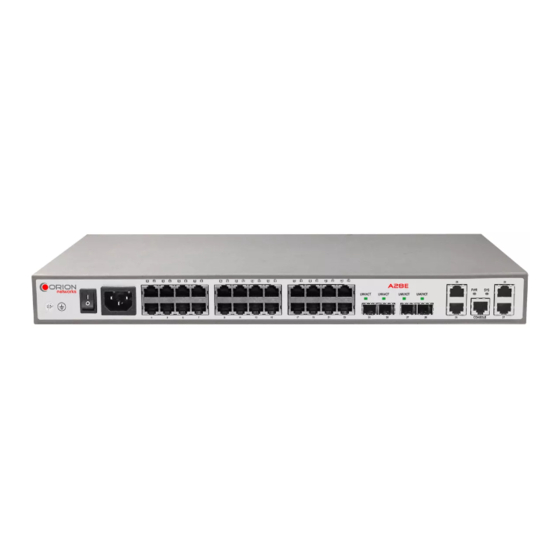
Table of Contents
Advertisement
Quick Links
Advertisement
Table of Contents

Summarization of Contents
Basic Configurations
Accessing the Device
Introduces methods for accessing the device via CLI or NView NNM.
CLI
Introduces the Command Line Interface and its features.
Managing Users
Covers user management, including creating and managing user accounts.
Managing Files
Covers management of BootROM, system, and configuration files.
Configuring Clock Management
Covers system time, time zone, DST, NTP, and SNTP configurations.
Configuring Interface Management
Covers interface attributes, flow control, and enabling/disabling interfaces.
Configuring Basic Information
Covers configuring the device name and language.
Task Scheduling
Explains how to configure periodic execution of commands.
Watchdog
Covers the configuration of the Watchdog function for system stability.
Load and Upgrade
Covers loading configuration files and upgrading system software.
Ethernet
MAC Address Table
Introduces the MAC address table, its function, and configuration.
VLAN
Introduces Virtual Local Area Network (VLAN) concepts and configuration.
QinQ
Introduces QinQ (Stacked VLAN) technology and its configuration.
VLAN Mapping
Introduces VLAN mapping for replacing private VLAN Tags with Carrier VLAN Tags.
Interface Protection
Introduces interface protection for Layer 2 data isolation.
Port Mirroring
Introduces port mirroring for monitoring network traffic.
Layer 2 Protocol Transparent Transmission
Introduces transparent transmission of Layer 2 protocol packets.
IP Services
ARP
Introduces Address Resolution Protocol (ARP) for IP to MAC mapping.
Layer 3 Interface
Introduces Layer 3 interfaces for device management and routing.
Default Gateway
Introduces the configuration of the default gateway for packet forwarding.
DHCP Client
Introduces DHCP Client for dynamic IP address assignment.
DHCP Relay
Introduces DHCP Relay for providing service across different network segments.
DHCP Snooping
Introduces DHCP Snooping for security and IP/MAC binding.
DHCP Options
Introduces DHCP options for transmitting control and configuration parameters.
QoS
Introduction
Introduces Quality of Service (QoS) for managing network resources.
Configuring Basic QoS
Covers enabling and configuring basic Quality of Service functions.
Configuring Traffic Classification and Traffic Policy
Covers classifying traffic and applying traffic policies.
Configuring Priority Mapping
Covers mapping priorities for queue scheduling and service differentiation.
Configuring Congestion Management
Covers configuring queue scheduling algorithms to manage network congestion.
Configuring Rate Limiting based on Interface and VLAN
Covers configuring rate limiting based on interfaces and VLANs.
Configuring Examples
Provides examples for configuring QoS features like congestion management.
Multicast
Overview
Introduces multicast concepts, groups, sources, and routers.
Configuring IGMP Snooping
Covers configuration of IGMP Snooping for Layer 2 multicast.
Configuring MVR
Covers Multicast VLAN Registration (MVR) for sharing multicast VLANs.
Configuring MVR Proxy
Covers MVR Proxy mechanism for managing multicast groups.
Configuring IGMP Filtering
Covers IGMP filtering rules for controlling user access to multicast groups.
Maintenance
Covers maintenance commands for multicast features.
Configuration Examples
Provides examples for configuring multicast features.
Security
ACL
Introduces Access Control Lists (ACL) for packet filtering.
Secure MAC Address
Covers port security MAC for controlling network access by MAC address.
Dynamic ARP Inspection
Introduces Dynamic ARP Inspection for ARP spoofing attack prevention.
RADIUS
Introduces RADIUS for remote authentication, authorization, and accounting.
TACACS+
Introduces TACACS+ for network access authentication and accounting.
Storm Control
Covers storm control to prevent broadcast storms.
802.1x
Introduces 802.1x for VLAN-based network access control.
IP Source Guard
Introduces IP Source Guard for preventing IP source spoofing.
PPPoE+
Introduces PPPoE+ for adding user identification to authentication packets.
Loopback Detection
Introduces loopback detection for improving network error tolerance.
Line Detection
Introduces line detection for analyzing physical link status and faults.
Reliability
Link Aggregation
Covers combining multiple physical interfaces into a logical link.
Interface Backup
Covers interface backup for redundancy and quick switching.
Failover
Introduces failover for port linkage and uplink failure response.
STP
Introduces Spanning Tree Protocol for eliminating network loops.
MSTP
Introduces Multiple Spanning Tree Protocol for VLAN flow distribution.
ERPS
Introduces Ethernet Ring Protection Switching for ring network fault recovery.
RRPS
Introduces Rapid Ring Protection Switching for rapid protection features.
System Management
SNMP
Introduces Simple Network Management Protocol (SNMP) for network management.
KeepAlive
Introduces KeepAlive mechanism for neighbor detection.
RMON
Introduces Remote Network Monitoring (RMON) for network traffic monitoring.
LLDP
Introduces Link Layer Discovery Protocol (LLDP) for topology discovery.
Extended OAM
Introduces Extended OAM for remote configurations and monitoring.
Optical Module DDM
Introduces Digital Diagnostic Monitoring (DDM) for SFP module diagnostics.
System Log
Introduces system log for recording and outputting system information.
Power Monitoring
Introduces power monitoring for detecting power failure alarms.
CPU Monitoring
Introduces CPU monitoring for real-time state, utilization, and stack usage.
Ping
Covers the Ping command for testing IPv4 network connectivity.
Traceroute
Covers the Traceroute command for testing IPv4 network connectivity.
Appendix
Terms
Defines technical terms used in the document.
Abbreviations
Lists and defines abbreviations used in the document.


Need help?
Do you have a question about the A28F and is the answer not in the manual?
Questions and answers